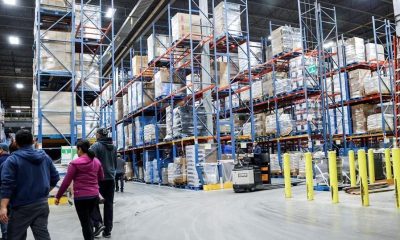Business
Facts vs. Fiction: What you need to know about EVs in Canada – Global News

From dinner table discussions to radio call-in shows, electric vehicles are a hot topic of conversation in Canada.
Will Canada be able to meet the 2035 mandate imposed by the Liberal government of Prime Minister Justin Trudeau for all new car sales to be electric? Will all those Teslas, Chevy Bolts, and Hyundai Ioniqs overwhelm and break the grid, as many fear? And what then of the batteries? Is disposing of them after their useful life is over going to create a landfill nightmare scenario?
We look at some of the top questions Canadians have about EVs, and provide some responses.
This is a big watercooler conversation in Canada. The concern is that all those EVs coming online in the next decade or so will be too much for provincial power grids to bear. Though not directly related to the preponderance of EVs, grid instability is, after all, what happened this past winter in Alberta during a cold snap, when residents received alerts warning them to reduce electricity consumption or face rolling outages.
Experts say it’s important to understand that it’s not as though all the cars on the road are going to become electric tomorrow. It’s a process that’s going to take place over 10, 20, even 30 years as internal combustion vehicles reach their natural end cycle and get taken off the road. This amounts to an extra burden on the grid of one or two percentage points of additional usage per year, according to University of Toronto engineering professor Daniel Posen. Another way to look at it, he says, is that’s about a 15 to 40 per cent increase from now until 2050 — all within the realm of manageability.
“This is not like it’s going to creep up on us by surprise,” Posen says.
But it also doesn’t mean that provinces and municipalities don’t have to plan for more power use, as drivers wean off the gas station and start charging their vehicles, he adds. “We have to plan.”
More power generating capacity as well as more transmission and distribution lines will become the norm, and over time, it will happen.
“It’s a challenge we can overcome. This is not the first time that we’ve had a change in our energy demand profiles.”
Range anxiety is still a thing
There are about 25,000 charging stations installed all over the country, in cities big and small, and everything in between. You can see a map of them on Natural Resources Canada’s site, as well as on the Plugshare app.
Increasingly, small businesses are helping fill the gaps in the public charging network.
Kendra Imrie owns a guest ranch in Falcon Beach, Manitoba, about 140 kilometres east of Winnipeg, along the Trans Canada Highway. Her property is located in Whiteshell Provincial Park, which does not have any public charging stations in it.
So, two years ago, when a representative from Tesla cold called her one day and asked if she’d be open to installing an EV charging station at the ranch, she immediately accepted.
“It’s an extra perk for our customers, our guests,” she says, adding that the stations are available to drivers who are passing by on the nearby highway.
Though having a charging station can be a boon to business, whether you’re a motel, a brewery or a guest ranch, most EV charging happens at home, and home-charging is the backbone of the EV industry.
Not everyone lives in a single family home, of course, and that’s where municipal policies to encourage, or mandate, condo-garage parking come in.
British Columbia, says Maxime Charron, the CEO of charging startup LeadingAhead Energy, was a leader in this respect. It introduced a law last year, Bill 22, to make it easier for strata corporations to put in EV charging in condo parking lots. That’s a game-changer because it’ll make it much less daunting for apartment dwellers to make the leap to purchasing an EV.
Where’s that power going to come from, and will it create pollution?
Emissions from electricity production would be a bigger problem if Canadian provinces depended entirely or mostly on fossil fuels — coal and fossil gas — to produce electricity. In Canada, however, the majority, though not all, of electricity is produced from renewable sources: 60 per cent comes from hydroelectric sources. Nuclear is not an insignificant portion of electricity production.
Most of the electricity produced in Canada comes from non-polluting sources, though not all of it. Alberta had set a 2030 deadline to wean itself off coal-powered electricity; it is well ahead of that schedule, and has almost kicked coal to the curb. Ontario has done the same.
Global News / Canada Energy Regulator
In provinces like Quebec, Manitoba and British Columbia, hydro power dominates.
Even Alberta, home to most of Canada’s oil sands production, a major source of pollution in the country, is very close to kicking coal to the curb. Ontario, for its part, is investing in nuclear energy, and has also eliminated its dependence on coal.
Still, converting every vehicle on the road to an EV will not meet Canada’s carbon-reduction mitigation goals. Why?
Oil and gas production, agriculture, buildings, airplanes, even electricity, these are all sources of carbon pollution that need to be “decarbonized” over time. But there’s no denying that decarbonizing automobile transportation is a big step in the right direction in terms of reducing emissions. It is the second biggest source of planet-heating greenhouse gas emissions in Canada.
How will we hit the 2035 mandate for an all-electric fleet?
Much has been made of the ambitious nature of the 2035 mandate for all new vehicles in Canada to be electric.
“First of all, I don’t think we’re going to get the infrastructure in place to charge these vehicles,” which, he says, continue to be too prohibitively expensive for the average customer.
One thing that everyone agrees on is that it isn’t going to happen overnight, and won’t happen without major effort on the policy and regulation front.
“There are real challenges to electrification including affordability and charging infrastructure,” argues Brian Kingston, the president and chief executive of the Canadian Vehicle Manufacturers’ Association.
But EV watchers say that while the 2035 target is ambitious, it is not impossible. Quebec and B.C. are proven case studies for that.
In the third quarter of 2023, according to Statistics Canada, 33 per cent of new car registrations in British Columbia were either battery-electric, hybrid-electric or plug-in hybrid vehicles. In Quebec, 27 per cent of new car sales last quarter were electric.
Quebec and British Columbia lead the country in terms of the most rapid expansion of battery electric vehicle sales. This chart shows the number over battery electric (BEV) registrations. It does not include plug-in hybrid electric vehicles (which are also considered zero-emissions, because they have the potential to produce no tailpipe emissions) nor hybrid electric vehicles.
Global News / Statistics Canada
“So, to say that we won’t be able to reach those targets doesn’t take into consideration the simple fact that car manufacturers — most of them — will always comply but will always complain,” says Daniel Breton, the president and CEO of Electric Mobility Canada, an EV advocacy group.
Norway is the poster child for how to get more EVs on the road. Over 80 per cent of new-car sales there are electric.
How did Norway do it? The Scandinavian nation not only incentivized customers to purchase EVs, it also took the bold step of disincentivizing the purchase of gas-powered cars. Nobody likes to pay more taxes, but Norway made it clear — if the car you drive pollutes the air, you need to pay for that.
The battery replacement cost versus the price of a new EV
There were at least two high-profile examples over the last year of EV drivers whose battery replacement costs were more than the cost of the actual vehicle — one horror story in B.C., the other in Ontario.
In terms of battery repair and replacement, the challenge, says Mubasher Faruki, the associate dean for the automotive division at the British Columbia Institute of Technology, comes down to training and experience. Many dealers and auto shops, he says, still need to up their game when it comes to repairing battery vehicles.
When a vehicle comes in with a defective battery, he wonders how familiar technicians are with that battery. Do they know how to open the battery, look at its components, and see whether they can be repaired? In other words, if you take your EV to the shop with a defective battery, are the technicians opening up the compartment to look at the battery before deciding it’s a writeoff?
These, Faruki says, are unanswered questions that over time, and with more training (and more EVs on the road) will become easier to answer — and less expensive.
That education, he says, is happening with more vigour. “One of the things that we’re doing in our course is we’re teaching technicians to take a deeper dive into these things,” he says.
He says all over the world, battery engineers and technicians are working on ways to improve range, “repairability” and the recycling capacity of batteries. It’s not inconceivable, he says, to have a battery that can go 1,000 kilometres on a single charge, and get recharged in 30 minutes.
Meanwhile, next-generation batteries are increasingly using materials that do not require cobalt, and the child-labour associated with cobalt extraction that has widely been reported on.
EVs are not the only solution
EVs are not the only solution to the world’s environmental and climate challenges.
They are still cars, and, as such, they take energy to manufacture and operate. Even though research shows that EVs outperform gas cars in terms of reducing planet-warming within a few short years of hitting the road (especially in places where electricity is not cleanly produced), the EV experience is still an energy-intensive one.
The key to reducing emissions, and creating a more livable environment, experts say, isn’t just to put more EVs on the road. Rather, better urban planning to develop medium-to-high density, walkable, transit-oriented communities will be critical.
Still, says Joanna Kyriazis of Clean Energy Canada, “many Canadians are still very reliant on their cars, especially as housing prices are skyrocketing and people are needing to move further and further away from where they work.”
This means, more communities will have to introduce “right-to-charge” policies whereby upgrading facilities in condo buildings will become a right and not a privilege.
But, “there’s no question,” says U of T engineer Daniel Posen, “that driving less, switching from a gas car to either active transit and biking, walking or to public transit — those things are going to have a bigger impact than switching to an electric vehicle.”
Business
Roots sees room for expansion in activewear, reports $5.2M Q2 loss and sales drop

TORONTO – Roots Corp. may have built its brand on all things comfy and cosy, but its CEO says activewear is now “really becoming a core part” of the brand.
The category, which at Roots spans leggings, tracksuits, sports bras and bike shorts, has seen such sustained double-digit growth that Meghan Roach plans to make it a key part of the business’ future.
“It’s an area … you will see us continue to expand upon,” she told analysts on a Friday call.
The Toronto-based retailer’s push into activewear has taken shape over many years and included several turns as the official designer and supplier of Team Canada’s Olympic uniform.
But consumers have had plenty of choice when it comes to workout gear and other apparel suited to their sporting needs. On top of the slew of athletic brands like Nike and Adidas, shoppers have also gravitated toward Lululemon Athletica Inc., Alo and Vuori, ramping up competition in the activewear category.
Roach feels Roots’ toehold in the category stems from the fit, feel and following its merchandise has cultivated.
“Our product really resonates with (shoppers) because you can wear it through multiple different use cases and occasions,” she said.
“We’ve been seeing customers come back again and again for some of these core products in our activewear collection.”
Her remarks came the same day as Roots revealed it lost $5.2 million in its latest quarter compared with a loss of $5.3 million in the same quarter last year.
The company said the second-quarter loss amounted to 13 cents per diluted share for the quarter ended Aug. 3, the same as a year earlier.
In presenting the results, Roach reminded analysts that the first half of the year is usually “seasonally small,” representing just 30 per cent of the company’s annual sales.
Sales for the second quarter totalled $47.7 million, down from $49.4 million in the same quarter last year.
The move lower came as direct-to-consumer sales amounted to $36.4 million, down from $37.1 million a year earlier, as comparable sales edged down 0.2 per cent.
The numbers reflect the fact that Roots continued to grapple with inventory challenges in the company’s Cooper fleece line that first cropped up in its previous quarter.
Roots recently began to use artificial intelligence to assist with daily inventory replenishments and said more tools helping with allocation will go live in the next quarter.
Beyond that time period, the company intends to keep exploring AI and renovate more of its stores.
It will also re-evaluate its design ranks.
Roots announced Friday that chief product officer Karuna Scheinfeld has stepped down.
Rather than fill the role, the company plans to hire senior level design talent with international experience in the outdoor and activewear sectors who will take on tasks previously done by the chief product officer.
This report by The Canadian Press was first published Sept. 13, 2024.
Companies in this story: (TSX:ROOT)
The Canadian Press. All rights reserved.
Business
Talks on today over HandyDART strike affecting vulnerable people in Metro Vancouver

VANCOUVER – Mediated talks between the union representing HandyDART workers in Metro Vancouver and its employer, Transdev, are set to resume today as a strike that has stopped most services drags into a second week.
No timeline has been set for the length of the negotiations, but Joe McCann, president of the Amalgamated Transit Union Local 1724, says they are willing to stay there as long as it takes, even if talks drag on all night.
About 600 employees of the door-to-door transit service for people unable to navigate the conventional transit system have been on strike since last Tuesday, pausing service for all but essential medical trips.
Hundreds of drivers rallied outside TransLink’s head office earlier this week, calling for the transportation provider to intervene in the dispute with Transdev, which was contracted to oversee HandyDART service.
Transdev said earlier this week that it will provide a reply to the union’s latest proposal on Thursday.
A statement from the company said it “strongly believes” that their employees deserve fair wages, and that a fair contract “must balance the needs of their employees, clients and taxpayers.”
This report by The Canadian Press was first published Sept. 12, 2024.
The Canadian Press. All rights reserved.
Business
Transat AT reports $39.9M Q3 loss compared with $57.3M profit a year earlier

MONTREAL – Travel company Transat AT Inc. reported a loss in its latest quarter compared with a profit a year earlier as its revenue edged lower.
The parent company of Air Transat says it lost $39.9 million or $1.03 per diluted share in its quarter ended July 31.
The result compared with a profit of $57.3 million or $1.49 per diluted share a year earlier.
Revenue in what was the company’s third quarter totalled $736.2 million, down from $746.3 million in the same quarter last year.
On an adjusted basis, Transat says it lost $1.10 per share in its latest quarter compared with an adjusted profit of $1.10 per share a year earlier.
Transat chief executive Annick Guérard says demand for leisure travel remains healthy, as evidenced by higher traffic, but consumers are increasingly price conscious given the current economic uncertainty.
This report by The Canadian Press was first published Sept. 12, 2024.
Companies in this story: (TSX:TRZ)
The Canadian Press. All rights reserved.
-

 Sports19 hours ago
Sports19 hours agoDolphins will bring in another quarterback, while Tagovailoa deals with concussion
-

 Sports21 hours ago
Sports21 hours agoDavid Beckham among soccer dignitaries attending ex-England coach Sven-Goran Eriksson’s funeral
-

 News21 hours ago
News21 hours agoVancouver Whitecaps cautious of lowly San Jose Earthquakes
-

 Sports15 hours ago
Sports15 hours agoEdmonton Oilers sign defenceman Travis Dermott to professional tryout
-

 News21 hours ago
News21 hours agoAlberta town adopts new resident code of conduct to address staff safety
-

 Tech17 hours ago
Tech17 hours agoUnited Airlines will offer free internet on flights using service from Elon Musk’s SpaceX
-

 Sports8 hours ago
Sports8 hours agoKirk’s walk-off single in 11th inning lifts Blue Jays past Cardinals 4-3
-

 News19 hours ago
News19 hours agoUnifor says workers at Walmart warehouse in Mississauga, Ont., vote to join union





















